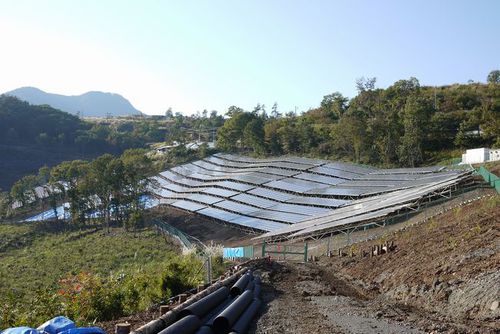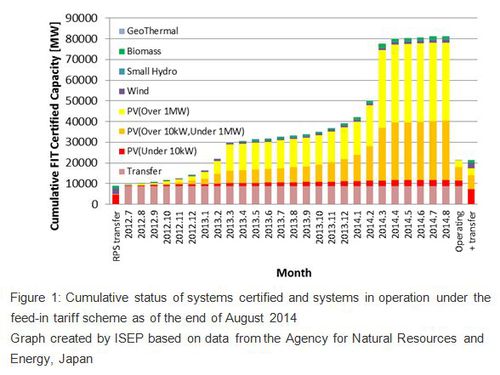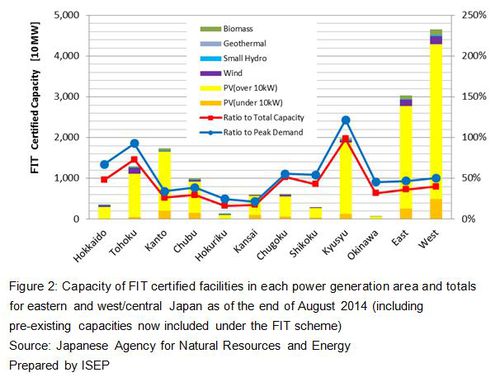January 24, 2015
Achievements of Japan's Feed-In Tariff Scheme and Challenges for Power System Reform
Keywords: Energy Policy Newsletter Renewable Energy
JFS Newsletter No.148 (December 2014)

Image by gridsurfer Some Rights Reserved.
As JFS reported in an article released on November 3, 2014, Japan's power companies have put on hold their responses to renewable energy applications.
JFS article:
Japan's Power Utilities to Suspend Responding to Clean Energy Applications
In response to this situation, the Japanese non-profit group Institute for Sustainable Energy Policies (ISEP) released a paper on October 2, 2014, describing opinions and proposals regarding some power companies' decisions to suspend responding to renewable energy applications based on an analysis of how to move the situation in a favorable direction. This issue of the JFS newsletter will introduce a briefing provided by ISEP's Hironao Matsubara on the outcome of the Feed-In Tariff (FIT) scheme introduced in Japan in July 2012, its contribution to wider use of renewable energy and future challenges.
---------------------------------------
Two years have passed since the start of Japan's Feed-in-Tariff (FIT) scheme in July 2012, which aims at a full scale unfurling of renewable energy. Statistics are starting to show some outstanding achievements of this FIT scheme during these first 2 years. Photovoltaic power generation in particular has been spreading rapidly across Japan. By the end of fiscal 2013, the cumulative total of photovoltaic installations reached about 14 million kilowatts, almost double the fiscal 2012 level. As a result, renewables (excluding large-scale hydropower) account for about 4.7% of the total power generated in Japan. If large-scale hydropower plants with an output over 10,000 kilowatts are included, renewables' share account for about 11%.
Meanwhile, the introduction and output of other renewable energy sources such as wind, geothermal, small-hydro and biomass remain on a plateau. More lead-time will be needed to overcome barriers to increases in these energy sources. The breakdown of energy from renewable sources is 1.3% from solar, 0.5% from wind, 0.2% for geothermal, 1.6% for small-hydro, and 1.1% for biomass.
The Ministry of Economy, Trade and Industry began releasing data on the FIT scheme, such as the amount of installed capacity and the number of facilities per municipality, on its website in fiscal 2014. Data on total generation output nationwide is available in the Comprehensive Energy Statistics released by the Agency for Natural Resources and Energy and in other sources.
From July 2012 to the end of August 2014, newly installed generation capacity from renewables certified by the FIT scheme exceeded 72 million kilowatts. About 96 percent of this capacity is from solar power, and 52 percent of that figure comes from large-scale solar facilities with output capacity of over 1 megawatt. The capacities of other renewables come to about 1.3 million kilowatts each for wind power and biomass, about 300,000 kilowatts for medium and small hydropower, with only 14,000 kilowatts for geothermal.
To promote the development of these categories of renewable sources even further, it will be necessary to steadily overcome challenges such as streamlining the environmental assessment process, reforming land use zoning, building consensus in society, and constructing the infrastructure needed for a stable electricity supply. About 17% of newly approved facilities have started operation with a capacity of about 12 million kilowatts. Adding facilities that had already started operation just before the start of the FIT scheme (under previous renewable energy promotion laws), total capacity exceeds 21 million kilowatts. About 80% of renewable-generated energy is from solar power, 12% from wind and 6% from biomass.
Verifying the situation of certified facilities according to power service area reveals that Kyushu Electric Power Co. has certified a total capacity of about 20 million kilowatts including pre-FIT scheme facilities (see Figure 2). This is equal to the generation capacity of all power facilities held by Kyushu Electric as of the end of FY2012, which is estimated to be sufficient for nearly 120% of maximum power demand in FY2013.
Kyushu Electric is the only power company where total certified capacity exceeds the maximum power demand, and Tohoku Electric Power Co. has certified capacity equal to 93% of the maximum demand, accounting for about 73% of the capacity of all facilities in the Tohoku area. On the other hand, the Kanto, Chubu and Kansai areas with high electricity demand have certified only a limited amount of capacity, accounting for between 20% and 40% of maximum demand. Looking at the capacity in the comprehensive areas of East Japan (including Tokyo) and West/Central Japan (including Osaka and Nagoya) where electricity generation systems have been accommodated to each other in order to enable the use of an interconnected power system, the ratio of certified renewable energy facilities covers around 50% of maximum demand.
Although the FIT system obliges power companies to establish connections to the grid as an important prerequisite, some service areas are beginning to experience difficulties with connecting to power grid systems owned and managed by major power companies. Areas with a high concentration of solar power system connections in particular are facing difficulties; they have problems not only with thermal capacity of regional power grids, but also with the need for expensive grid enhancement required under current connection rules, when capacity shortages of extra-high voltage lines need to be upgraded. At present, the first company initiating a system connection in this case is obliged to bear the total construction fee for the upgrade.
In Europe where power grids are regarded as public infrastructure, power grid connection and operation costs are generally covered by transmission system operators (TSO) and distribution system operators (DSO), minimizing the burden on power producers. Fees are collected from wheeling (electric power transmission) charges under full-cost pricing system that distributes costs thinly and broadly over a long period of time. In Europe, renewable energy sources are given first priority for grid connections.
By contrast, in Japan, the fact that power producers have to bear the connection cost is causing the abovementioned problems. Despite the obligation to connect (with some exceptions), some power companies are virtually refusing to establish connections.
In Europe, the separation of utilities into electricity generation and transmission operators was legislated under an EU directive, resulting in extensive market facilitation and electricity deregulation. It is imperative for Japan to promote the separation of utilities into generation and transmission operators as soon as possible by implementing systemic reforms already planned and by establishing a structure that will enable power transmitters and distributors to systematically facilitate regional power grids without further loss of time.
On September 24, 2014, Kyushu Electric announced that it will suspend its responses to new applications for grid connections from renewable energy producers. Then, Tohoku Electric, Hokkaido Electric Power Co. and Shikoku Electric Power Co. all made similar announcements on September 30. The Ministry of Economy, Trade and Industry (METI) established a new Working Group on Grid Connection of Renewable Energy under the New and Renewable Energy Subcommittee, and announced its proposal for reviewing rules regarding grid connection based on estimates of potential connection capacity from solar power generation to the power grids owned by each power company.
The reason power utilities have suspended their responses to applications is reportedly the excessive amount of capacity that would be connected to the power grids --especially from solar power generation facilities -- certified under the FIT scheme. The total amount for all applications was a great deal larger than the acceptable capacity of all power utility companies, as estimated under the operating conditions of existing power grids. At the working group meeting to review grid connection problems and rules, calculations of acceptable capacity from solar power generation facilities to the power grids owned by each power company were discussed in an open session for the first time.
However, the calculating method used to estimate of power companies' capacity for power grid connection from renewable energy sources is not likely to contribute to the full scale unfurling of renewable energy use. This method presupposes the existing connection and operation guidelines, and factors such as adjustment of supply-demand balance and transmission of power outside the service area through grid interconnections are not usually taken into account in Japan. However, examples from European countries show that it is possible to further increase the amount of renewable energy by reviewing such connection and operation guidelines.
Therefore, reformation of power grid operation and the conventional electricity system is an urgent task for Japan. Since many stakeholders are involved in this issue, including power companies, renewable energy producers and local interested parties, a fair and transparent process of deliberation is essential to promote full-scale implementation of renewable energy development.
Principally, taking rules that guarantee priority access to the grid for renewable energy as a starting point, it will be necessary to review guidelines for existing base-load power sources -- such as coal-fired power generation and currently suspended nuclear power generation -- while disclosing the necessary information. Nuclear power generation should not be regarded as a base-load power source under the same standards as those that were applied previous to the Fukushima nuclear accident in 2011.
Furthermore, it is important to comprehensively reform the electric power system and review energy policy. To this end, short-term measures to deal with the problems that have been identified will not suffice; a medium- to long-term vision for energy policy as well as clear and ambitious goals for introducing renewable energy and energy conservation must also be set.
Although the Procurement Price Calculation Committee already functions as an official third-party body for deliberations regarding the FIT scheme, the New and Renewable Energy Subcommittee of the Advisory Committee for Natural Resources and Energy also started to review the scheme, and its proposed revisions were released on December 18, 2014. This review of the FIT scheme includes practical measures for progress in its reform in FY2015. At the same time, close coordination between these committees will be required in reconsidering procurement costs in line with the main goal of maximum adoption of renewable energy.
Meanwhile, the Working Group on System Design under the Electricity System Reform Subcommittee has been studying detailed designs for reforming Japan's electricity systems. The process toward designing a full-scale electricity market and separating power generation and transmission should be open to the public. In addition, systems and policies that encourage a broad introduction of renewable energy that is also sustainable in the medium- to long-term perspective are needed.
Written by Hironao Matsubara, Institute for Sustainable Energy Policies
Related
"JFS Newsletter"
- 'Good Companies in Japan' (Article No.4): 'Eightfold Satisfaction' Management for Everyone's Happiness
- "Nai-Mono-Wa-Nai": Ama Town's Concept of Sufficiency and Message to the World
- 'Yumekaze' Wind Turbine Project Connects Metro Consumers and Regional Producers: Seikatsu Club Consumers' Co-operative
- Shaping Japan's Energy toward 2050 Participating in the Round Table for Studying Energy Situations
- 'Good Companies in Japan' (Article No.3): Seeking Ways to Develop Societal Contribution along with Core Businesses




